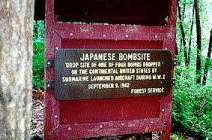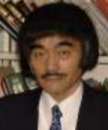|
Mainland United States has never been
bombed . . . WRONG!
peace and good will during his first visit in 1962. The sword was placed in the mayor's office, where it remains today. He also was host to a group of Brookings-Harbor High School students at his home in Japan. He was an honored guest at the 1990 annual Azalea Festival in Brookings. The Brookings City Council declared Fujita an honorary citizen. Fujita's ashes now rest on the same spot where his first bombs landed just east of Brookings.
|
||||||||||||||||||||||||||||
| In May of 1995 we had some
visitors: Lyle and Jane Bower who came to Brookings to spend the
weekend with us. They flew into our local airport in their Beechcraft
Bonanza and we picked them up. Flying is the passion of Lyle's life
and he has spent his career as an instructor, corporate pilot, etc.
After a couple of days of visiting, we drove them back up to the
airport for their departure. Shortly after our arrival, we got involved
chatting with a local Brookings pilot by the name of Glen Woodfin,
who also owned a Beech Bonanza which he was pre-flighting. Glen told us he was waiting for Mr. Fujita to arrive and that he was planning |
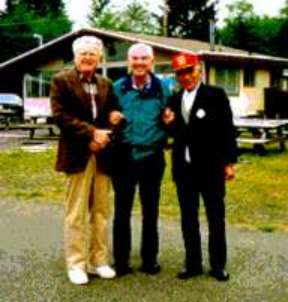 |
|
|
to fly him over the site where the bomb fell some fifty-plus years earlier. Sure enough, a few minutes later a car pulls up with Mr. Fujita and another person from Brookings.
Interestingly, no interpreter — this was a sign language operation
with a lot of smiling and bowing. Needless to say, we took advantage
of the opportunity to get a few pictures.
|
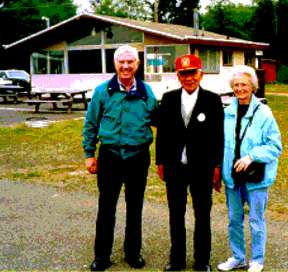 left to right myself, Fujita, my wife Patty |
We have forwarded some, including a
picture from our local newspaper, as well as a picture of the Fujita
family Samurai sword which is on display at our library. A somewhat humorous situation developed at the airport as the Bowers began to taxi for departure. The weather was not real great and the low ceiling was getting lower — probably close to minimums for an instrument take-off. Being a pilot too, it was not lost on Mr. Fujita that one Bonanza was taking off and the other Bonanza wasn't. The local pilot was trying to explain with gestures, inflections etc., that the mountain top they wanted to fly over was in the soup Mr. Fujita did a lot of listening, smiling |
| and made some signs of his own. We were to learn later that it was four or five hours before the ceiling lifted and they got to make their flight over the bomb site. | |
Being a native Oregonian, I still have recollection of the bombing event. Certainly there was never a thought in my mind that I might get to meet the pilot a half-century later and find him to be a sweet, cheerful man who was doing what he could to make amends.
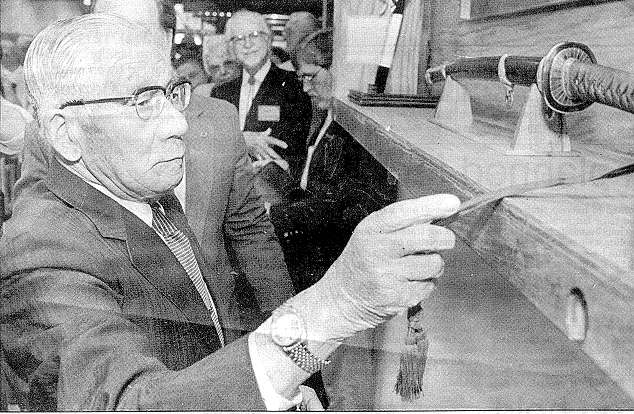 |
|
|
![]()
|
I know the fact at this time and I investigated various documents and newspaper accounts. I now know, for the first time, that Mr. Nobuo Fujita was rather famous among some Japanese people, although most Japanese people do not know. The item of this website described Mr. Nobuo
Fujita exactly. However, I could get some facts from above-mentioned
documents and newspaper accounts which were not described in the
item of this website. These facts will be briefly summarized below. He wrote a testamentary letter before he made a sally, since he believed that he would not return safely to the base. His bombing attack failed to cause any wood fire as would spread panic over the American people. The most possible reason was that the wooded regions in Oregon were considerably moist, because the weather had been stormy there before the days of the attack. After the war, he was surprised when he was invited by Brookings City, and he worried himself being judged as a war criminal. Eventually, he accepted the invitation and went to the U.S. On that occasion, he brought with him the hereditary Japanese sword with intention of killing himself if the worst should happen. When he arrived, however, he was expected with the citizens' cordial welcomes. At this time, he was deeply impressed with the broad-minded attitude of the country, USA, and he felt actually, for the first time, that Japan was defeated by USA. He decided to present the Japanese sword brought with him as a proof of peace to Brookings City. Furthermore, he intended to reward something to USA after he returned to Japan, since he was deeply impressed with the American generosities. He certainly succeeded as a businessman after the war, but his company went bankrupt later. Even so, he saved money from a small income over many years and he invited high school students in Brookings City with the money, because he was deeply touched by the American broad-minded attitude. In 1985, three girl students in Brookings City were invited to Japan. Some people remembered that he had acted as a guide for them with a really delightful look on that occasion. He was presented a dedicatory letter, "With admiration for your kindness and generosity" from President Reagan in those days. On September 30, 1997, Mr. Nobuo Fujita, 85 years old, died. A part of his ashes were brought to Brookings, because he had eager desire for placement of his ashes remains in his second home, USA." Then, why do not most of the Japanese people know him? What I am going to write is not the opinion of all Japanese people. This is my exceedingly personal opinion, but I am confident that my opinion shown below should not be quite wrong. What I must say first is that USA was a winner and Japan was a loser at World War ll. You American people have "an easy and graceful attitude as a winner," I think. That seems to be why they could invite Mr. Nobuo Fujita after the war. All winners at all wars do not necessarily have such generous attitude, of course. I believe that the American people's specific generosities in addition to "the generous attitude as a winner" may have led the fact that he was so welcomed. However, if USA had been defeated by Japan (although such a thing had been quite impossible!), I wonder the country should have invited him. Japan lost to USA at World War ll, and of course did not have "an easy and graceful attitude." After the war, Japan could be regenerated to the country where democracy is held in esteem. This is really a glad thing, and we may be indebted to the result (Japan lost the war to USA) for the regeneration. However, a phenomenon occurred in Japan in the process of the regeneration to the country where democracy is held in esteem after the war; the phenomenon was a trend showing that everything the Japanese people have conducted before the regeneration was wrong. In other words, the trend showed that everything the Japanese people had conducted at World War ll was wrong. On the basis of this trend, there is no hero of World War ll in Japan. "Any glorious achievement by the military personnel who fought at World War ll" does not exist, whatever achievement he did. However, this trend is a little changing in
some sectors of Japan. Mind you, American people, it is impossible
to make a website, such as "Kilroy was here", in Japan
yet! There is few or no website about Japanese veterans now. |
Send Corrections, additions, and input to:
|
Visitors since
June 6, 2000 |

